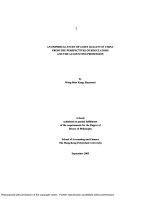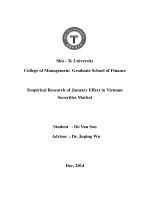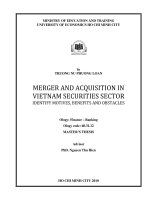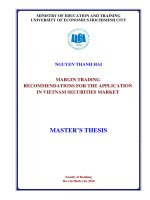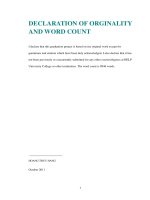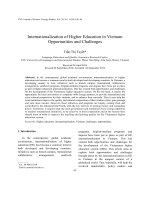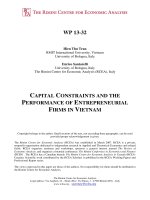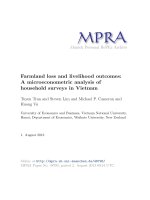Empirical Research of January Effect in Vietnam Securities Market
Bạn đang xem bản rút gọn của tài liệu. Xem và tải ngay bản đầy đủ của tài liệu tại đây (738.17 KB, 70 trang )
Shu - Te University
College of Management Graduate School of Finance
Empirical Research of January Effect in Vietnam
Securities Market
Student : Do Van Son
Advisor : Dr. Juping Wu
Dec, 2014
Empirical Research of January Effect in Vietnam
Securities Market
Student: Do Van Son
Advisor: Dr. Juping Wu
A Thesis
Submitted to
Department of Finance
Shu-Te University
In Partial Fulfillment of the Requirements
For the Degree of
Master of Finance
Dec, 2014
Graduate School of Finance, Shu-Te University
Empirical
R
esearch of January
E
ffect in Vietnam
Securities Market
Student: Do Van Son
Advisor: Dr. Juping Wu
Assoc.Pro. Dr. Nguyen Thu Thuy
ABSTRACT
The January effect implies that securities market experience in abnormal
return in January. In this thesis, I conduct the empirical research of the January
effect on monthly returns of Vietnam securities market, specifically VN-Index.
The research is aimed to find out the existence of January effect on overall period,
subperiods of VN-Index and on securities portfolio with different market
capitalization. By using the method of least square, the research result has shown
that January effect exists overall period of VN-Index with higher effect during
uptrend period but there has no effect during downtrend period. The effect also
does not exist on different market-cap portfolio during the downtrend period. The
observation of this effect can help investors to establish a profitable investment
strategy and effective risk management.
Keywords: January effect; Abnormal returns; Vietnam securities market;
Emerging Market
i
ACKNOWLEDGMENTS
I would like to take this opportunity to recognize the contribution of the
people who supported me in completing this thesis. Without their valuable
support and guidance, this thesis would not have been possible.
Firstly, I would like to express my gratitude to professors of the
University SHU-TE and the Foreign Trade University, who taught and helped me
throughout the course. Special thanks to my Academic Advisor Dr. Juping Wu
and Co-advisor Assoc.Prof.Dr. Nguyen Thu Thuy, who provided very useful
guidance and recommendation throughout the process of writing this thesis.
Their support is of vital importance to the successful completion of this thesis.
Secondly, I would like to thank to my MBAF4 companions and friends for
their sharing and helping me during the study at the MBA Program and for the
completion of this thesis.
Finally, I would like to send my deepest gratitude and love to my wife
and sons. Without their encouragement and continued support, I would not have
been able to complete the dissertation and the whole two years of studying the
MBA program.
Đỗ Văn Sơn – MBAF4, Shu-Te University, 2014
ii
TABLE OF CONTENT
ABSTRACT i
ACKNOWLEDGMENTS ii
LIST OF TABLES v
LIST OF FIGURES vi
ILLUSTRATION OF SYMBOLS vii
CHAPTER 1 - INTRODUCTION 1
1.1 Research background 1
1.2 Research questions and objectives 5
1.3 Scope of the research 5
1.4 Motivation of the research 5
1.5 Research procedure 7
CHAPTER 2 - THEORETICAL BACKGROUND 8
2.1 Overview of the January Effect 8
2.1.1 January Effect in securities markets 8
2.1.1.1 January Effect in Emerging Securities Market 8
2.1.1.2 January Effect in Developed Securities Market 9
2.1.1.3 January Effect is not unique to small firm but it is more statistically
significant with small firms. 10
2.1.2 Reasons for the January Effect 11
2.2 The concept and formula of Securities Index 12
2.2.1 The concept of securities index 12
2.2.2 The Formula for VN – INDEX 13
CHAPTER 3- RESEARCH METHODOLOGY 15
3.1 Research models for January effect 15
3.1.1 Non-linear pattern by a Taylor expansion 15
3.1.2 OLS methodology by Cristina Balint and Oana Gica (2012) 16
3.1.3 Time series Garch framework. 16
3.2. Estimation of research model, description and variable measurement 16
iii
3.2.1 Return calculation formula 16
3.2.2 Application of regression model to test the January effect on
VN-Index. 17
3.2.3 Application of regression model to test the January effect on VN-
Index’s sub-periods. 18
3.2.4 Application of regression model to test the January effect on
company’s market capitalization. 19
3.3 Research data 20
3.3.1 Securities market data 20
3.3.2 Company data 20
CHAPTER 4– DATA ANALYSIS AND RESEARCH RESULTS 23
4.1 The January effect on VN-Index in the period 2000 – 2013 23
4.2 The January effect on VN-Index in the period 2000 – 2007 25
4.3 The January effect on VN-Index in the period 2008 – 2013 27
4.4 The January effect on Large-cap Portfolio during period 2008 – 2013 . 28
4.5 The January effect on Mid-cap Portfolio during period 2008 – 2013 30
4.6 The January effect on Small-cap Portfolio during period 2008 – 2013 . 33
CHAPTER 5 – CONCLUSION 35
REFERENCES 38
ANNEX 41
iv
LIST OF TABLES
Table 1: Average returns by months of VNI during 2000 - 2013 13
Table 2: Market capital classification 21
Table 3 - Large-cap securities portfolio 21
Table 4 - Mid-cap securities portfolio 22
Table 5 - Small-cap securities portfolio 22
Table 6 - Tabulation of VN-Index Return in period 2000 - 2013 24
Table 7 - Regression model for VN-Index returns in period 2000-2013 24
Table 8 - Regression model for VN-Index returns in period 2000-2007 25
Table 9 – Lei Gao model for VN-Index returns in period 2000-2007 26
Table 10 - Regression model for VN-Index returns in period 2008-2013 27
Table 11 – Lei Gao model for VN-Index returns in period 2000-2007 28
Table 12 - Regression model for large-cap portfolio 29
Table 13 – Lei Gao model for Large-Cap Portfolio 30
Table 14 - Regression model for Mid-cap portfolio 31
Table 15 – Lei Gao model for Mid-Cap Portfolio 32
Table 16 - Regression model for Small-cap portfolio 33
Table 17 – Lei Gao model for Small-Cap Portfolio 34
v
LIST OF FIGURES
Figure 1: Return of Securities from 2000 to 2007 1
Figure 2: Return of Securities from 2008 to 2013 2
Figure 3: VN-Index performance in period 2000-2013 14
Figure 4: VN-Index histogram and descriptive statistics 23
vi
ILLUSTRATION OF SYMBOLS
1
−
t
R
: Return at month t-1
JAN
: Dummy variable of January
0
α
,
1
α
and
2
α
: Coefficient parameters
t
ε
: Error term.
: Weighted number of stock
: Return rate of stock i
m : Total number of stocks in the portfolio
ϕ
i :
are parameters
h
t
: is the variance of ϵ
t
)
(ts
P
: Price at time t of stock s
)1( −ts
P
: Stock price at time (t – 1)
vii
CHAPTER 1 – INTRODUCTION
1.1 Research background
Vn-Index officially operated since 27
th
July 2000 with the initial index of
100 points and reach to 571 points in 25 June 2001. By that time, there are a few
listed companies in the market. By the end of 2001, VNI went down to 235,4
points, and then 130 points in October 2003, the lowest point in VNI’s
performance history.
Hereinafter are the figures showing monthly returns of securities before
the economic recession (2000-2007) and during economic recession (2008-2013)
in Ho Chi Minh stock exchange from 2000 to 2013.
Figure 1: Return of Securities from 2000 to 2007
(Source: HOSE, own calculation)
The period 2006-2007 is considered as the “golden time” for VNI. By
that time, VNI reached to the highest point (around 1.138 points in February
2007) in history of this market. It is due to Vietnam’s joining to WTO, preferred
-50.00%
-40.00%
-30.00%
-20.00%
-10.00%
0.00%
10.00%
20.00%
30.00%
40.00%
Sep-00
Jan-01
May-01
Sep-01
Jan-02
May-02
Sep-02
Jan-03
May-03
Sep-03
Jan-04
May-04
Sep-04
Jan-05
May-05
Sep-05
Jan-06
May-06
Sep-06
Jan-07
May-07
Sep-07
VNI Return 2000 - 2007
Return
1
tax for listed companies, many good companies were listed…
Figure 2: Return of Securities from 2008 to 2013
(Source: HOSE, own calculation)
The period from 2008 to 2013 is considered as the down-trend period,
especially the period 2008-2009 is known as a “nightmare” to almost investors.
For example, VNI decreased in 7 consecutive trading days, wiping out 88,58
points, equivalent to 21%. The main reasons for this tragedy are financial crisis
in the US, debt crisis in EU countries and uncertain economy in Vietnam.
From the performance of Vietnam’s market, it can be seen that this
market is not efficient since investors behave on crowd-effect basis. For example,
on 25
th
November 2009, Vietnam’s State Bank has decision on adjustment of
foreign exchange rates and increase basic interest rate to 8% after 11 months
maintaining at 7%, so investors sold very aggressively and VNI decreased by
8,18% only in two days. Therefore, the understanding behavior of investors in
the market is very important for winning this market.
Inspite of its high fluctuation, Vietnam Securities Market is still an
important investment channel for investors, from professional investment
institutions to individual investors. Therefore, it is very significant for
-40.00%
-30.00%
-20.00%
-10.00%
0.00%
10.00%
20.00%
30.00%
Jan-08
May-08
Sep-08
Jan-09
May-09
Sep-09
Jan-10
May-10
Sep-10
Jan-11
May-11
Sep-11
Jan-12
May-12
Sep-12
Jan-13
May-13
Sep-13
VNI Return 2008 - 2013
Return
2
researchers in terms of the finding of its laws and signals to help market
participants have the base for making investment decision, state management
agencies have the base for policy issuances and market development orientations.
One of the issues that many researchers around the world, except Vietnam’s
researchers, pay much attention is abnormal return in securities market.
Returns generated by a given security or a portfolio over a period of time,
different from the expected rate of return or not conform to the law of Efficient
Market Hypothesis is known as abnormal returns. The Efficient Market
Hypothesis confirms that abnormal return does not exist in securities markets
because all information is reflected in stock prices. However, many investors are
trying to seek for abnormal return by learning on movement pattern of stock
prices in the past. The fact has shown that there exist such opportunities to earn
abnormal returns thanks to the taking advantage of some laws or seasonal effect
in securities market. Seasonal effects that many people are interested in are daily
effect of a week, January effect, May effect, October effect One of the effects
that many researchers are especially interested is January effect.
The January effect describes the abnormal return of stock prices in several
weeks at the end of December and at the beginning of January in next year. For
example, in January 2013, almost 20 largest markets’ index in the world
increases (except Brazil and Korea). Among those markets, Japan, China, UK,
Switzerland and Italy’s indices has higher increase than that of the US.
Specifically, in January 2013, Nikkei index of Japan went up by 7.2%,
Composite Shanghai (China) up by 6.5%, S&P500 (US) up by 5.5%. January
effect has been significant since 1950 in the US, because in past 63 years, only in
1987 this effect is not shown in the market.
In previous special reports, Rozeff and Kinney (1976) initially find that
the existence of seasonal laws of stocks and most of those laws prevail in January.
This finding has created a new research path for finding the existence of the
January effect, its reason and its conflicts with Efficient Market Hypothesis
3
(EMH). The reasons for hypothesis of abnormal return is rather abundant, for
example, Tax avoidance hypothesis, Windows dressing hypothesis and Liquidity
hypothesis.
Those above reasons have partly explained the abnormality of stock
returns but there is no true reason for January effect’s conflict with Efficient
Market Hypothesis. Therefore, the finding of a main reason for the explanation
purpose of those effects continues. Especially, investors in the US market have
more than five decades taking advantage of this effect to earn abnormal returns.
In Vietnam securities market, there are some common reasons as stated in
hypothesis above. Regarding the Liquidity hypothesis, Vietnam’s companies
usually pay salaries and bonuses at the end of the year as a very important
manner to encourage employees to contribute intensively in a new year.
Regarding the Windows dressing hypothesis, there are an abundant number of
public funds and private funds in Vietnam market that usually apply techniques
to “polish” their financial reports by selling unrealized-loss stocks at the end of
the year and buy it back at the beginning of next year. In Vietnam, The Vietnam
state Bank and commercial Banks usually expand credit intensively at beginning
months of the year, especially individual loans, so many investor expect such
loans to be invested into securities market. Besides, positive information to
support the market usually announced at the beginning of a year, thereby, having
a positive impact on securities index. The abnormality of stocks’ performance in
January has caused a conflict with Efficient Market Hypothesis. For such reasons,
the surveying and researching on January effect in Vietnam securities market is
quite feasible and bring many benefits to market participants. The control of
those abnormalities are essential, especially it should be controlled by state
management agencies. Therefore, the thesis “Empirical Research of January
Effect in Vietnam Securities Market” is implemented to find out and justify both
theoretical and practical in Vietnam securities market.
4
1.2 Research questions and objectives
This research aims to solve the following issues:
1. Does January Effect exist in Vietnam Securities Market?
2. What is the impact of January Effect on sub-periods of Vietnam
Securities Market (before economic recession and during economic
recession periods)?
3. What is the impact of January Effect on small-cap, mid-cap and
large-cap stocks in Vietnam securities market?
1.3 Scope of the research
This study examines Vietnam Securities Market and companies during the
period from September 2000 to December 2013. The research data is monthly
returns of VN-Index and company stocks from September 2000 to December
2013. Company data shall be collected accordingly with starting time of stocks
listed in Hochiminh Stock Exchange (HOSE).
1.4 Motivation of the research
With the application of financial models and Behavioral Finance Theory
used worldwide, the January effect has been tested in developed and emerging
markets. Vietnam securities market just has a development history of over 10
years; therefore, state management agencies, individual investors and
institutional investors do not have sufficient knowledge and experiences. At this
time, there is no thorough research on this seasonal effect in Vietnam securities
market. Therefore, the research on the existence and its reasons in Vietnam
securities market has a very important significance in terms of both theorical and
practical to whom its may be concerned. The research result is expected to
contribute and provide important findings on January effect and meet the
following objectives.
From academic perspective, this research shall provide additional
knowledge on January effect in Vietnam securities market and its evidence for
the existence or non-existence of January effect in Vietnam, especially the
5
increasing of small-cap stock prices in January from year to year. This research
shall provide empirical evidence for the comparison of Vietnam’s January effects
with other emerging and developed markets. Moreover, its research results may
also be utilized as a supplemental evidence for present researches on January
effects and provide useful information and findings for other future researches
and it is provide the basic research about the continue seasonal effect research on
Vietnam stock market, as well.
The seasonal pattern of market returns violates the assumption of weak
market efficiency in that by observing the past development of returns, market
participants can make extraordinary profit. Therefore, the perception of the
January effect existence and its law shall help investors to make wise investment
decisions, have a good timing of investment and have right strategies to generate
abnormal returns from this seasonal effect, thereby reducing risk of losing money
on their investment portfolios.
It is important to know the impact of January effect on different periods of
the market. The impact of January effect in high-growing economy is usually
higher than that in low-growing economy; therefore, investors should have good
strategy on such different stages or periods.
In addition, the impact of January effect may be different due to the
market capitalization of company. Statistical data has shown that January effect
usually has higher impact on small-cap companies; hence, investors should be
aware of this difference.
The January effect is one of seasonal effects reflecting the inefficiency of
securities market. To have an efficient market, it is important that state
management agencies should know about the reason for the existence of January
effect. The lack of transparence, price control, insider trading… still exists in the
market. This understanding shall facilitate them to issue sound policies for
market development and efficiency improvement of Vietnam securities market.
6
1.5 Research procedure
As we know that this effect is significant in global securities market.
Therefore, many foreign researchers have found out models to prove the
existence of this effect. This thesis’s main goal is also to find the evidence for the
January effect in Vietnam.
Chapter 1: Introduction
Chapter 2: Theoretical background
To study the January effect in the world and its reasons for January effect. The
research methodology and data collect from Vietnam Securities market is
introuduced in
Chapter 3: Research Methodology
Providing a suitable model from tested models widely used by researchers from
China, Romanie, USA, etc.shall be selected for its application to Vietnam’s
market data. Specifically, the January effect on different stages of the securities’
index and on different market cap portfolio shall be tested with the quantitave
model. The finding of this research shall be very useful and significant for both
business and academic fields in Vietnam.
Chapter 4: Data analysis and research results
To provide detail results of empirical test for the January effect on different
periods and market-cap potfolios.
Chapter 5: Conclusions
To provide for lesson learnt, its significance and future research issues.
In next chapter, the literature review shall be done in order to learn about
the study results of worldwide researchers, through which we can know how the
January effect on different markets and the reasons for its existence. This
analysis shall be the basis for the research of the January effect in Vietnam’s
securities market.
7
CHAPTER 2 - THEORETICAL BACKGROUND
2.1 Overview of the January Effect
2.1.1 January Effect in securities markets
The January effect, also known as the turn-of-year effect, is a calendar
effect wherein securities increase in value more rapidly than in other months.
Although in Vietnam there is no thorough research on the January Effect, there
have many studies concerning the January Effect in the world.
2.1.1.1 January Effect in Emerging Securities Market
Wong, Agarwal and Wong (2006) state that in the pre-crisis period (1993-
1997), the January effect exists in Singapore market. However, analysis in the
post crisis period shows that such anomality has significantly declined or
disappreared.
Chung-Wen (2005) states that Taiwan index and Hongkong index show
high probability of the existence of January effect.
Wong, Ho and Dollery (2007) test monthly effect in Kuala Lumper
Composite Index for the period from January 1994 to December 2006. For the
whole period, the monthly effect does not exist. However, when the three sub-
periods are examined, the regression results confirmed a monthly effect in stock
returns. It is found that the results are positive and significant for January and
February during the post-crisis and pre-crisis period respectively. The results also
indicate the existence of negative March and September effects for the post-crisis
period.
Deyshappriya (2014) examines the Stock Market Anomalies in Colombo
Stock Exchange, Sri Lanka during the period of 2004 to 2013. The existences of
Monthly effect has been tested using monthly data. The Ordinary Least Square
(OLS) method were employed to capture the effect. The sample period was
divided into two periods as War Period and Post War Period in order to take the
8
impact of the War into account. The result has showed that statistically
significant positive January and negative December effects were observed for the
War period and entire sample period. However, the irregular monthly effect has
been found for post War period with significant positive April, September and
December effects but not January.
Nageswari, Selvam, Vanitha and Babu (2013) use the logarithmic data for
S&P CNX Nifty and S&P CNX 500 sample indices and applied the Dummy
Variable Regression Model from 1stApril 2002 to 31st March 2011. The result
indicates the highest mean return was earned in December and the lowest/
negative mean return earned in January Month for S&P CNX Nifty index. The
S&P CNX 500 Index recorded the Highest Mean Return in the Month of March
and the Highest Negative Mean Returns in the Month of January. It is also found
that there was significant difference in the mean returns among the different
months of the year. The analytical results of seasonality indicate the absence of
January Anomaly during the study period.
Ahsan and Sarkar (2012) study the January Effect in Bangladesh stock
market from 1987 to 2012 but the results did not show the January Effect. In fact
during the sample period, mean stock return from December to April was
negative.
2.1.1.2 January Effect in Developed Securities Market
Marret and Worthington (2011) do the empirical research in the Australian
market to find out the monthly effect on Austrialian Stock Exchange Index’s
return and industry returns. At the market level, evidence is found of
significantly higher returns in April, July and December (up to nearly three times
higher than average returns across all months). It is interesting that the impact for
small cap firms is even more significant with January, August and December
returns being 5.3, 3.9 and 4.9 times higher than mean return throughout the year.
At the sub-market level, monthly effects are found in the diversified financial,
energy, retail, telecommunications and transport industries, but not in the
9
banking, healthcare, insurance, materials and media industries. Of these, the
most substantial month-of- the-year effects at the industry level relative to mean
industry returns are January returns in the retail industry which are more than
twice as low as returns in other months of the year and in the telecommunications
industry where they are more than thirty-three times higher.
Tylor (2007) tests the January effect across 16 countries (Australia,
Austria, Belgium, Canada, Denmark, France, Germany, Hongkong, Italy, Japan,
Neitherlands, Spain, Sweden, Switzerland, UK and US) for the period January
1970 – December 2006. and found the effect is significant in 7 countries, while a
surprising September seasonal is significant in 13 countries.
Gultekin (1982) finds evidence of a seasonal pattern in the stock return in
most of the major industrial countries (Australia, Belgium, Canada, Denmark) in
the period 1/1959 to 12/1979). The seasonality is usually manifested in a
significantly larger mean return at the turn of the tax-year. For most countries,
this large return occurs in January.
2.1.1.3 January Effect is not unique to small firm but it is more statistically
significant with small firms.
Thaler (1987) concludes that January effect is primary a small firm
phenomenon. The logic is that an equal-weighted index is a simple average of the
prices of all firms listed on the NYSE. Small firms have greater weight than their
share of market value.
Gica & Balint (2012) test Romania market from January 2003 to
December 2010 and find that in the pre-crisis period (2003 to 2008), the January
Effect only exists in small-cap stocks.
Later on, the researchers want to find out if January effect is exclusively to
small firm effect. Kohers and Kohli (1991) use the data of the S&P composite
index, which consist of large firm securities, and the results show that January
effect was independent of the small firms effect. That is, January effect was not
exclusively small firm effect.
10
It can be concluded that January effect is not unique to small firms but it is
more common with small firms, especially for those whose prices had declined
the previous years.
2.1.2 Reasons for the January Effect
Most previous studies about the January Effect have indicated that some
reasons for the January effect as below:
2.1.2.1 The theory of liquidity (Liquidity hypothesis): Ogden (1990) states that
cash flow tends to increase in January because at the end of year, the company
pay salary and bonus to motivate employee for their contribution in company’
operation, so investors’ bonuses and salary are indirectly or directly invested on
market including stock market. These cash flows are then put into securities
directly or indirectly through either mutual fund or pension fund, followed by an
upward trend in January.
2.1.2.2 Tax avoidance hypothesis: Branch (1977) points that December is the
time of tax finalization so investors tend to sell loss securities to reduce taxes on
financial assets. Because the tax is applied for return that happened, also investor
shall sell unrealized loss stocks to reduce portfolio returns, thereby decreasing
income tax. When supply increases, it would put pressure on reducing the price
of securities in December. However, in January, starting the new fiscal year,
stock index goes up since investors tend to buy back securities to rebalance a
new portfolios’ investment.
2.1.2.3 Window dressing hypothesis: Haugen and Lakonisk (1988) declare that
fund managing director of the company with negative profit want to avoid
financial losses by selling unrealized loss securities in fund's portfolio to better
their financial statements and only retained unrealized gain securities. In January,
they sell unrealized gain securities and retain unrealized loss securities. These
transactions put pressure on stock price to decrease at the end of the year and
increase in the early next year.
2.1.2.4 Other Macroeconomic Factors
Schneeweis and Woolridge (1979) imply that seasonality is not
11
necessarily inefficient, and some embedded factors such as the monetary policy,
risk adjustment, tax consideration, and the seasonal information difference, make
the equity returns seasonal. Therefore, seasonality may exist in the efficient
markets.
2.1.2.5 Financial Payment Systems
Ogden (1990) shows the hypothesis that the standardization of the
payment system in US is a reason for cash demand by the end of each month,
especially December, and investors, who have substantive cash receipts at the
turn of the month will increase their demand of stocks.
2.1.2.6 Traditional point of view is that good news on company’s business
operation shall be published at the end of the year. Stock prices increase in
January to reflect such information; therefore, return is usually higher in January
as a seasonal effect.
2.2 The concept and formula of Securities Index
2.2.1 The concept of securities index
Securities index provides information for investors to analyze and
evaluate securities market in general; indicating the fluctuations of securities
prices and is the fundamental assessment of securities market’s performance.
This is very important information for listed companies, investors, state
management agencies and becomes a barometer of the economy in terms of their
business operation, management, investment
Securities index is a relative measure (calculated by the number of
“points”), by comparison relationship between the current value of average stock
price and the basis index at the first (basis) date (usually set at 100 or 1000 at the
basis date). Securities index comprises two factors, including the number of
shares outstanding (weighted factor) and stock price. For example, in the early
period of Vietnam securities market, VN-Index is the only index representing the
market value on the stock exchange market. The index is calculated by weighted
market value of listed shares. In July 2005, HNX-Index is constructed and used
12
as a representative index for stocks listed in Hanoi Stock Exchanges (HASTC).
2.2.2 The Formula for VN – INDEX
Securities index is computed by using the Weighted average method with
the Weighted factor as the number of outstanding shares listed at the time of
calculation. The formula of Passcher is used as below:
INDEX (points) =
100
) Q0 x (P0
) Q1 x (P1
n
1i
ii
n
1
i
ii
×
∑
∑
=
=
(1) in which:
i
P1
: Closing market price of share i at the reporting date
i
P0
: Closing market price of share i at the basis date
i
Q1
: Number of outstanding share i at the reporting date
i
Q0
: Number of outstanding share i at the basis date
n: The number of shares to calculate the index
2.2.3 The performance of VN-Index during 2000-2013
VN-Index performance in the period from 2000 to 2013 has showed the
following mean return for each month of the year:
Table 1 : Average returns by months of VNI during 2000 - 2013
Month
January
February
March
April
May
June
Average return
5.31%
-0.24%
1.94%
4.17%
0.23%
0.58%
Month
July
August
September
October
November
December
Average return
-4.06%
-1.61%
0.19%
-2.70%
-0.95%
-1.01%
Source: HOSE and own analysis
Among months’ returns, January’s return has the highest value than other
remaining months. Therefore, we can assume that there may exist the January
effect in Vietnam’s market.
The following figure is monthly VN-Index Chart from 2000 to 2013:
13
Figure 3: VN-Index performance in period 2000-2013
Source: HOSE and own analysis
Looking at this VN-Index Chart, we clearly see that VN-Index’s
Fluctuation is the highest in period from 2006 to 2009 and It is known as a
“nightmare” to almost investors when VN- Index decreased about 1000 points in
period from 2008 to 2009. The period from 2009 to 2013, the VN-Index
continuously declined 200 points. But it gradually is stable tendancy.
In next chapter, we shall choose the suitable model to test the January
effect in Vietnam securities market.
A M J J A S O N D 2004 A M J J A S O N D 2005 A M
J J
A
S O
N D
2006
A M
J J
A S O N D 2007 A M J J A S O N D 2008 A M J J A S O N D 2009 A M J J A S O N D 2010 A M J J A S O N D 2011 A M J J A S O N D 2012 A M J J A S O N D 2013
A M J J A S O
N
D 2014
A
150
200
250
300
350
400
450
500
550
600
650
700
750
800
850
900
950
1000
1050
1100
1150
1200
1250
VNINDEX (586.650, 587.110, 563.550, 578.560, -7.91998)
Year
VNI
14
